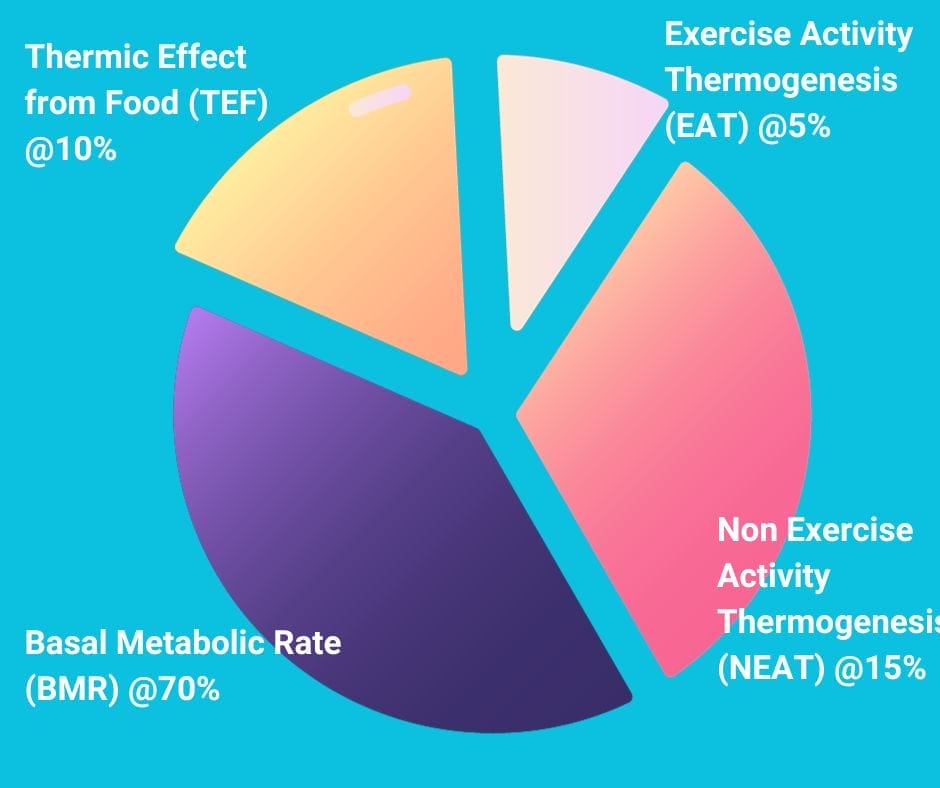When I ask prospective clients what they think they need to do to accomplish their weight management goal(s), most of them lean heavily on the idea of “getting in more cardio”. This is certainly a useful (and healthy) idea to a certain point.
But I think often, the prospective client is missing an equally, perhaps more potent option. Amongst weight management clients, there is almost universally an under reliance on strength training to help them accomplish their goal. Today, I want to focus on why getting stronger is one of the most valuable activities you can do in the gym
… even if,
… especially if
… you have a fat loss goal.
Personally, I would place the highest priority on my nutrition if I had a specific weight management goal. But many times, clients just aren’t ready to commit to that type of work in the beginning so we’ll save that conversation for another day.
Metabolism
We can break our caloric expenditure (metabolism) down into 4 main categories.
#1: Basal Metabolic Rate (BMR)
Your BMR is the calories you burn at rest. Lying in bed, just breathing and processing. Our BMR accounts for approximately 70% of all the calories we burn in a day. As you can see, your systems and organs require a great deal of energy to function.
#2: Non-Exercise Activity Thermogenesis (NEAT)
NEAT is all the stuff we do that isn’t exercise. Stuff like walking, taking out the trash, fidgeting while you talk on the phone. Neat accounts for about 15% of the calories we will burn in a day.
#3: Exercise Activity Thermogenesis (EAT)
This is planned or purposeful exercise. EAT accounts for 10% of our daily calorie expenditure.
#4: Thermic Effect of Food (TEF)
Finally, we have TEF. These are the calories we burn to digest the food we eat. It’s always been a little funny to me that EAT is exercise and TEF is food.
Oh well.

Strength Training as an Effective Weight Management Tool
Given that our BMR accounts for approximately 70% of the calories we’re going to burn in a day, I’m going to propose we aim to increase our BMR.
How do I increase my BMR, you ask?
You lift weights and prioritize building muscle!!!
A significant portion of your BMR comes from your muscles. When we focus on getting stronger, our muscles grow and repair. When they grow and repair, they burn a lot of calories. When you burn a lot of calories, your body fat decreases. And when that happens, you hit your goal(s).
Cardiovascular exercise does provide a significant calorie burn while you’re doing the activity, but resistance training is such a potent tool for fat loss because an athlete will continue burning a higher rate of calories long after the lifting session has been completed.
This term is known as EPOC and relates to the increased metabolic activity present during the growth and repair that follows resistance training.
What About Nutrition?
You might be thinking that appropriate nutrition habits would trump cardiovascular activity and resistance training when it comes specifically to weight management, and you’d be correct. That doesn’t mean that we should ignore the obvious potency of adding more muscle and strength to help the athlete reach his/her goals.
Lastly, some athletes may require more advanced strategies that include surgery and/or pharmacology to reach their weight management goals. And we certainly would acknowledge that weight training won’t (likely) meet all the needs that an athlete may have when it comes to managing their weight, we simply find strength training as a great place to start.
This is a common conversation topic. I previously wrote about it here: The Best Way to Lose Weight
You can also check out this conversation I had with coach Alex on Brentwood Barbell Radio, ep 19: Weight Management
Stronger By Science also put out this great article, where we referenced some of their numbers on metabolism: The Definitive Diet Setup Guide: How to Build and Adjust a Smart Nutrition Plan
Talk soon,
James

